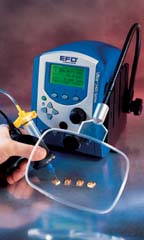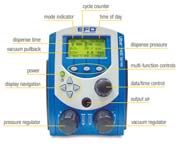Finding new ways to build products faster, better and more cost-effectively can be a powerful tool for manufacturers struggling to stay profitable in a global marketplace where consumers demand more features, higher quality, and lower prices. The new Ultra™ Dispensing Workstation from EFD Inc., East Providence, RI, provides an easily implemented way for these companies to improve their production processes, as well as their bottom lines.
The majority of assembly operations involve at least one adhesive, sealant, threadlocker or other fluid. While some companies still use squeeze bottles and toothpicks in simple low-volume processes, manual applicators are almost never a cost-effective option when hidden expenses like rework, rejects and fluid waste are factored in.
Many companies using adhesives or other assembly fluids have been able to increase yields and reduce production costs by using air-powered dispensers to regulate the amount of material applied. By using controlled air pressure instead of operator guesswork to determine deposit size, they ensure that workers apply a consistent amount of material on every part.

Changing Face of Manufacturing Creates New Dispensing Requirements
Traditional dispenser designs - typically a horizontal console with a digital time display and analog gauges for air pressure and vacuum - have provided excellent results for well over a decade. However, increasing trends toward smaller products, tighter tolerances, offshore manufacturing and "lean" initiatives have prompted many manufacturers to seek greater accuracy, simpler operation for global workforces, and quick reconfiguration for rapidly changing products and applications.In response to these challenges, EFD developed the Ultra 2400, an advanced dispensing workstation that provides more precise fluid control in crucial applications, multilingual readouts in standard and metric increments, and a unique system of side panels and accessories that allows the unit to be customized for different applications - all in a compact package that takes up 60% less space than standard dispenser configurations.

Smaller Part Geometries, Tighter Tolerances Require Greater Fluid Control
Air-powered dispensers operate on compressed air and electricity and use a combination of time, air pressure, and tip diameter to control deposit size. The operator loads the fluid into a disposable syringe barrel attached to the dispenser by a lightweight air line, sets the time and pressure controls to produce the desired deposit size, and presses an electric foot pedal to initiate the dispensing cycle, putting a consistent amount of adhesive on each part.Dispense time is the simplest and most precise way to adjust deposit size. Standard dispensers typically allow time settings to be adjusted in tenths, hundredths or thousandths of a second, but critical applications like medical devices and fiber optics often require even greater precision. A fourth decimal place was added to the Ultra 2400, enabling manufacturers to fine-tune their deposits in increments as small as 0.0001 seconds. A new internal pressure reservoir and a fast-acting solenoid were also added to provide consistent deposits in as short a time setting as 2 milliseconds. The extremely fast response improves fluid control and allows the user to produce consistent deposits as small as 0.004" in diameter.
Better Process Control in Four Languages
While many industries require formal process control and validation programs, any company can benefit from the higher yields, better quality and lower production costs that result when fluid deposits become more consistent.Most air-powered dispensers use a mix of analog gauges and digital readouts to display the time, pressure and vacuum (to keep thin fluids from dripping) settings used to determine deposit size. To simplify setup and operation of the 2400 Workstation, EFD used an LCD panel large enough to simultaneously display all dispensing parameters, including time, pressure, vacuum and shot count. The all-digital display is more accurate and reliable than analog gauges, and makes it easier for the user to quickly set and document an absolute value for each setting.
Sixteen memory cells allow the settings used for different jobs to be stored and recalled each time those jobs are run, which promotes standardization among different facilities, thereby reducing the chance of input errors during setup. A password protection feature prevents adjustment by unauthorized personnel.
Since many companies today have both domestic and overseas production facilities, the 2400 incorporates several features to help ensure that all facilities produce identical results, regardless of geographic location. Displays can be viewed in English, French, German or Spanish in standard or metric increments. The unit also comes with a selection of international power plugs, and will automatically adjust for input voltages from 85 to 265 volts.
Customized for Different Fluids and Applications
The Ultra 2400's vertical design conserves benchtop space (a major consideration in many overseas facilities) and accommodates a detachable shelf that allows two dispensers to be stacked on top of each other. Slotted panels on either side of the workstation provide secure attachment for optional accessories that allow the user to optimize the unit for maximum efficiency in different applications. These include a high-intensity task light, a syringe holder that acts as a convenient "third hand," a large magnifier on a flexible arm for close-up work, and an ergonomic pistol-grip syringe holder that allows the dispense cycle to be initiated by a touch sensor instead of the foot pedal.Each workstation comes with a supply of disposable components (syringe barrels, pistons and tips) carefully matched to the individual user's fluid and dispensing application. Options include general-purpose clear barrels, amber barrels that block light from 240-550 nm, and opaque black barrels for total light protection. Tips have internal diameters from 0.060" to 0.004", in styles that include stainless steel general-purpose tips, tapered polyethylene tips for thick fluids like RTV (room temperature vulcanizing) silicones, and Teflon-lined tips for cyanoacrylates and other reactive fluids.
By combining different syringe barrels, tips, and accessories, companies can easily create customized dispensing systems that will help them increase productivity - and profits - in virtually any adhesive dispensing application.
For more information on dispensing equipment, contact Tom Muccino, Business Development Manager, EFD Inc., 977 Waterman Ave., East Providence, RI 02914; phone (800) 556-3484 or (401) 434-1680; fax (401) 431-0237; e-mail tmuccino@efd-inc.com ; or visit http://www.efd-inc.com .